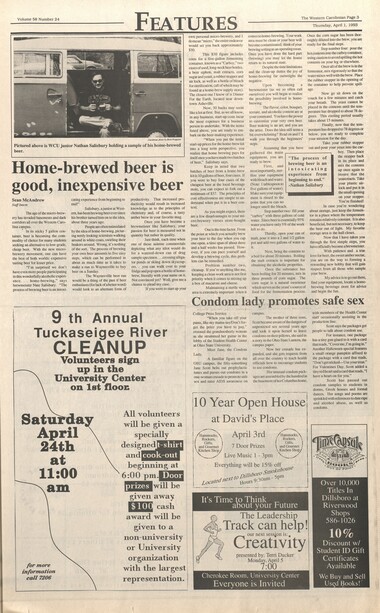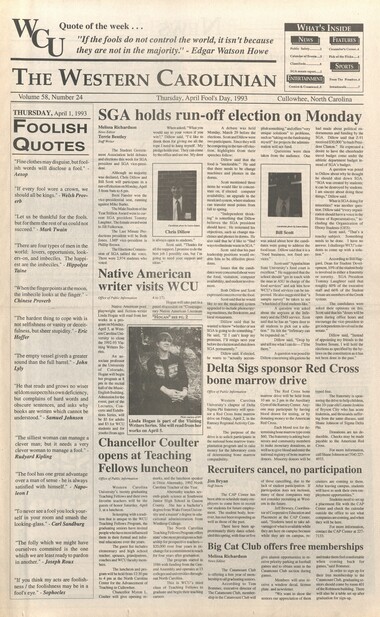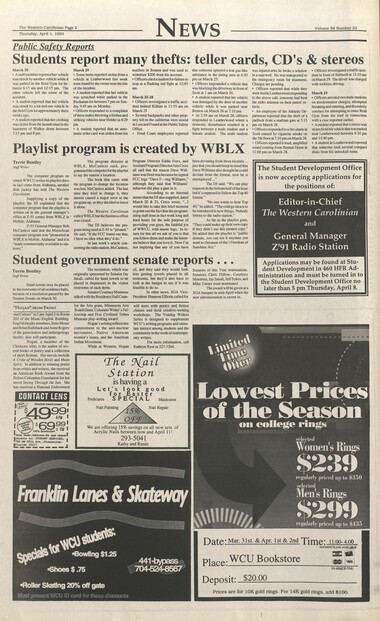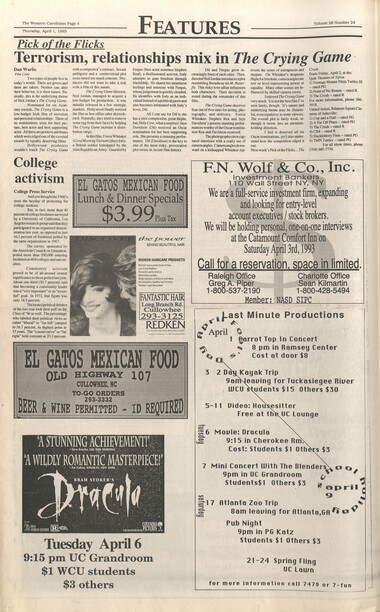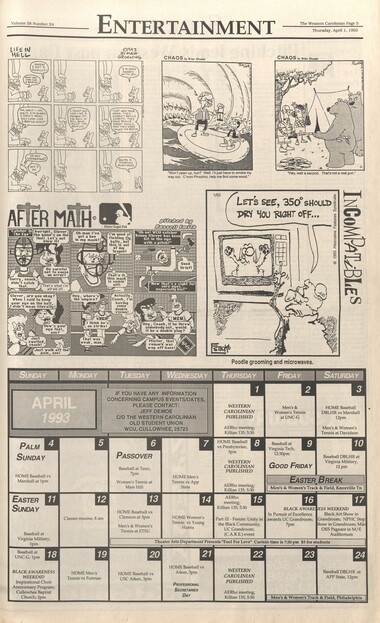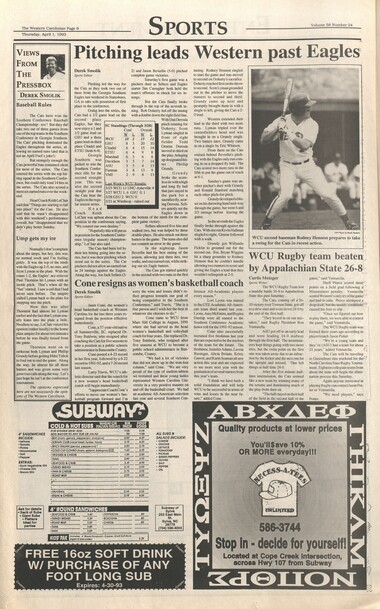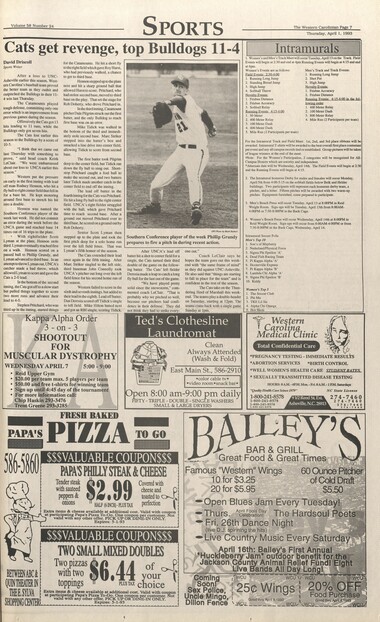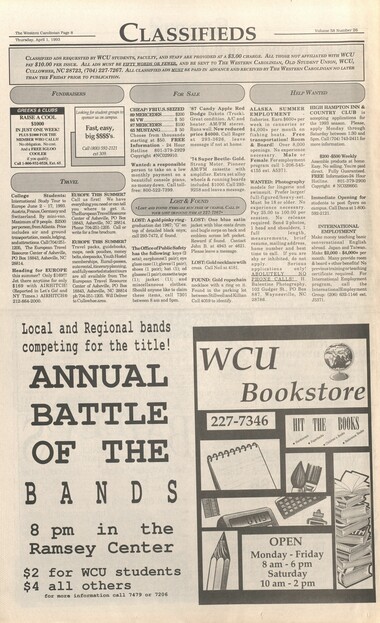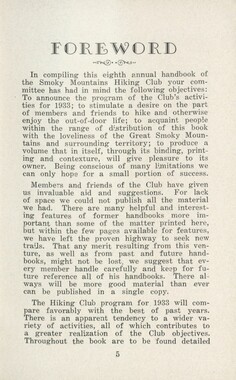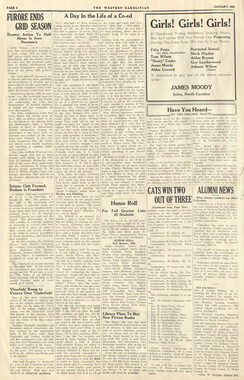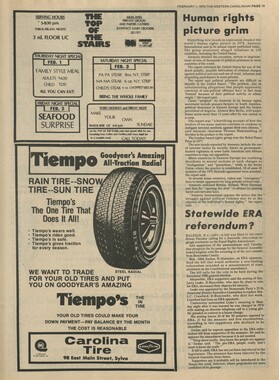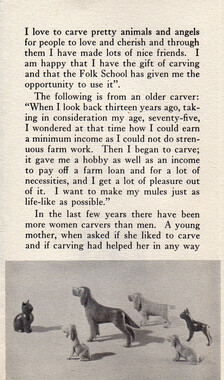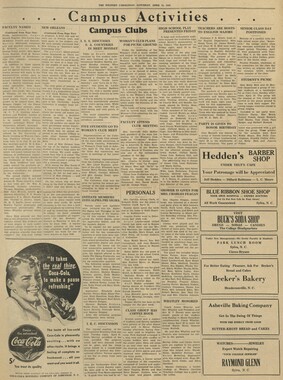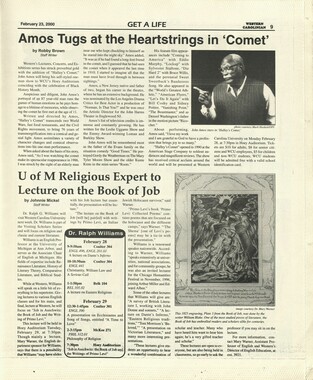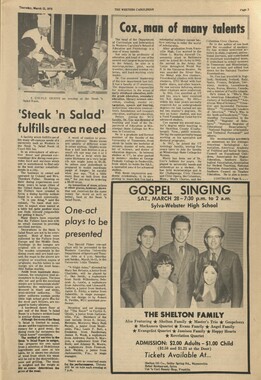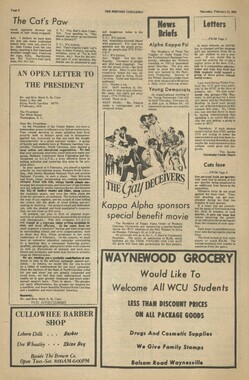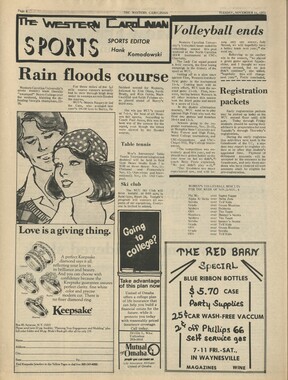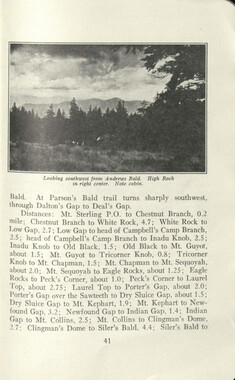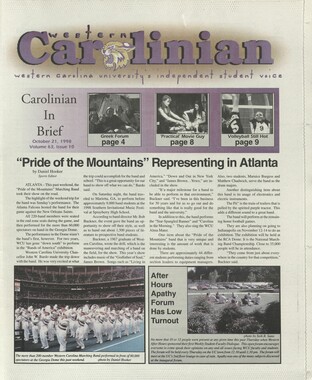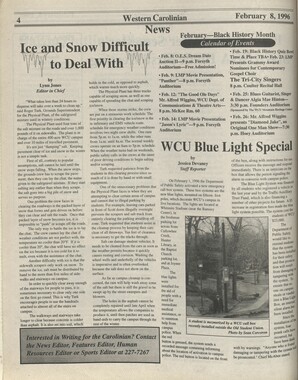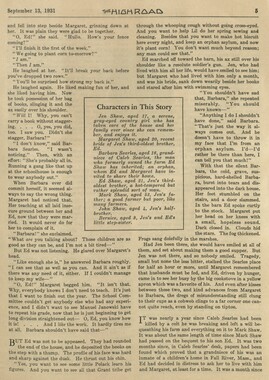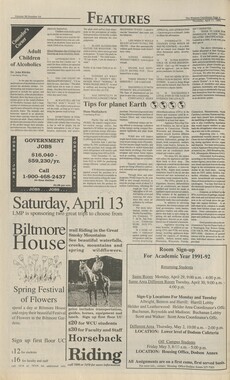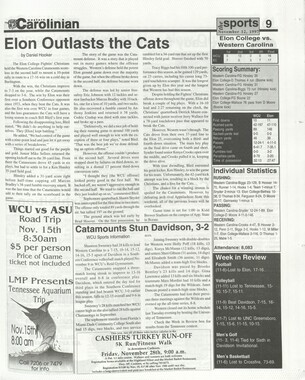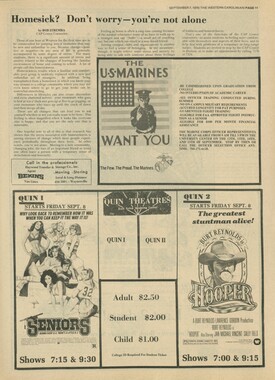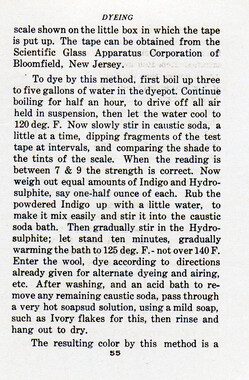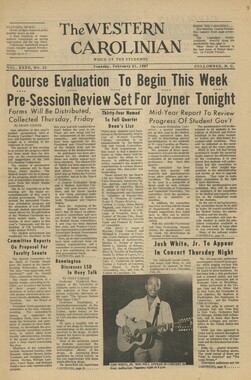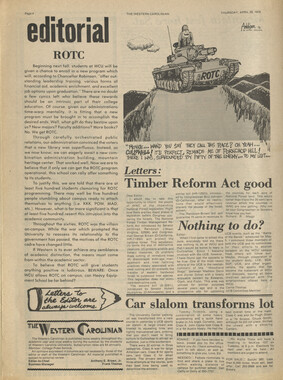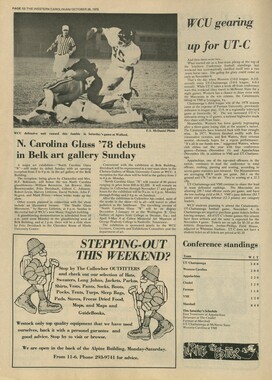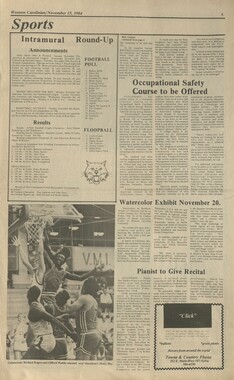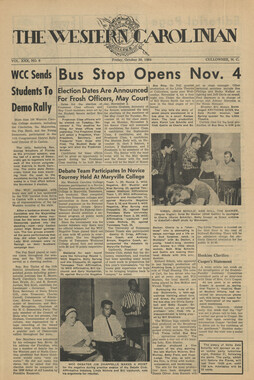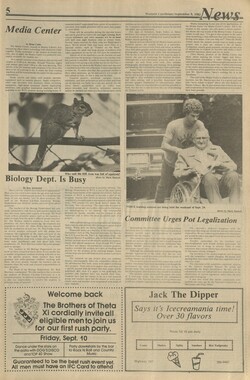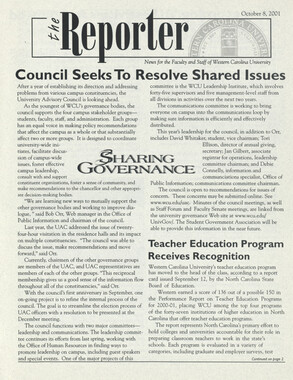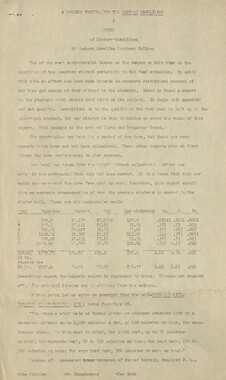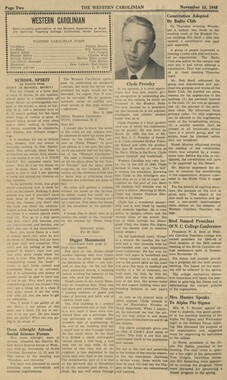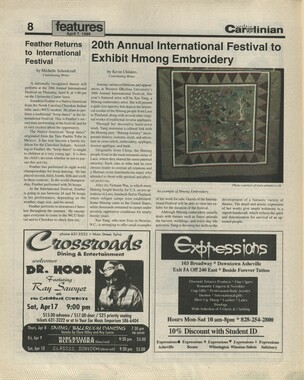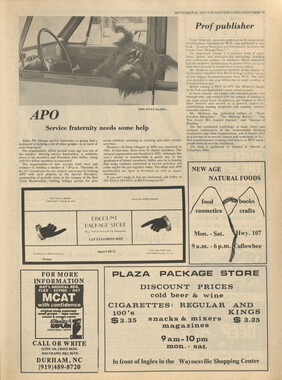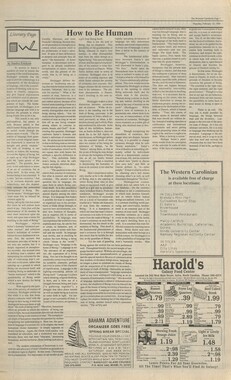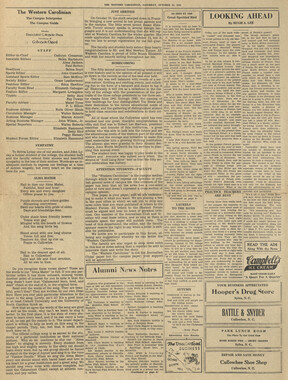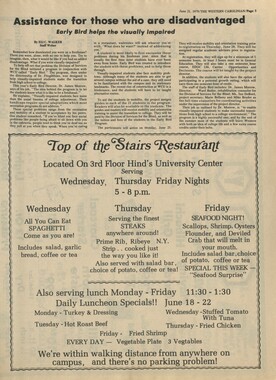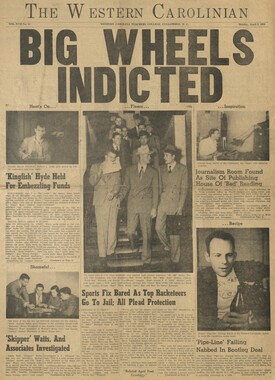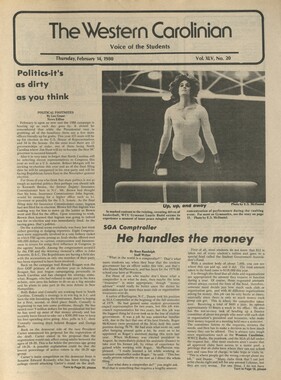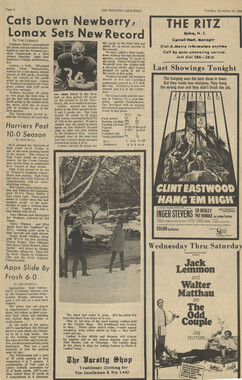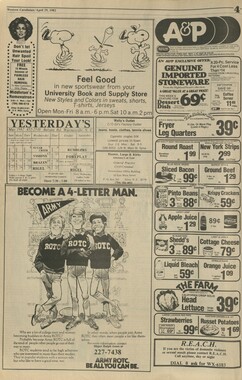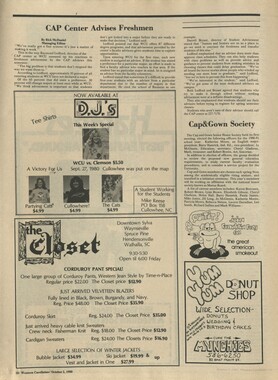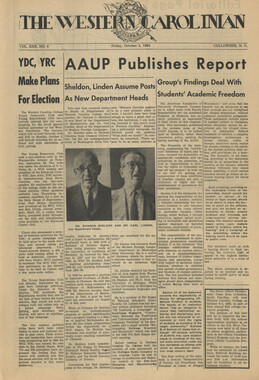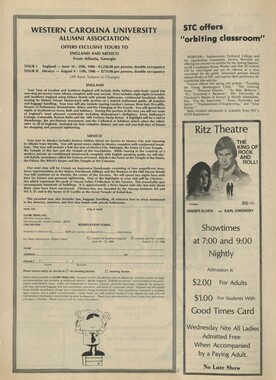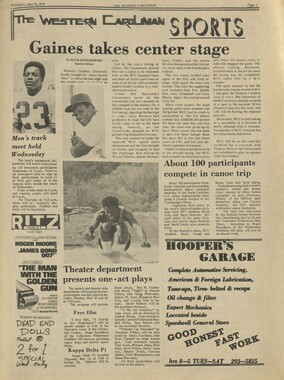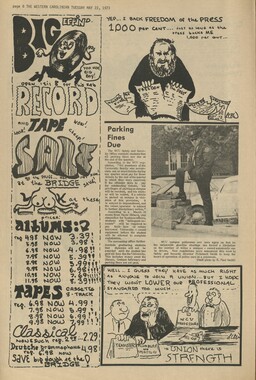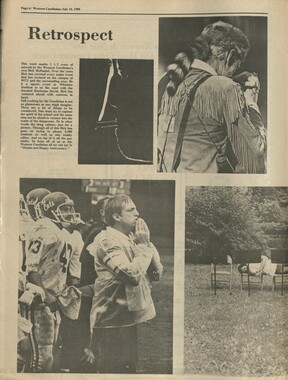Western Carolina University (20)
View all
- Canton Champion Fibre Company (2308)
- Cherokee Traditions (293)
- Civil War in Southern Appalachia (165)
- Craft Revival (1942)
- Great Smoky Mountains - A Park for America (2767)
- Highlights from Western Carolina University (430)
- Horace Kephart (941)
- Journeys Through Jackson (154)
- LGBTQIA+ Archive of Jackson County (26)
- Oral Histories of Western North Carolina (314)
- Picturing Appalachia (6772)
- Stories of Mountain Folk (413)
- Travel Western North Carolina (160)
- Western Carolina University Fine Art Museum Vitreograph Collection (129)
- Western Carolina University Herbarium (92)
- Western Carolina University: Making Memories (708)
- Western Carolina University Publications (2283)
- Western Carolina University Restricted Electronic Theses and Dissertations (146)
- Western North Carolina Regional Maps (71)
- World War II in Southern Appalachia (131)
University of North Carolina Asheville (6)
View all
- Allanstand Cottage Industries (62)
- Appalachian National Park Association (53)
- Bennett, Kelly, 1890-1974 (1388)
- Berry, Walter (76)
- Brasstown Carvers (40)
- Carver, George Washington, 1864?-1943 (26)
- Cathey, Joseph, 1803-1874 (1)
- Champion Fibre Company (233)
- Champion Paper and Fibre Company (297)
- Cherokee Indian Fair Association (16)
- Cherokee Language Program (22)
- Crowe, Amanda (40)
- Edmonston, Thomas Benton, 1842-1907 (7)
- Ensley, A. L. (Abraham Lincoln), 1865-1948 (275)
- Fromer, Irving Rhodes, 1913-1994 (70)
- George Butz (BFS 1907) (46)
- Goodrich, Frances Louisa (120)
- Grant, George Alexander, 1891-1964 (96)
- Heard, Marian Gladys (60)
- Kephart, Calvin, 1883-1969 (15)
- Kephart, Horace, 1862-1931 (313)
- Kephart, Laura, 1862-1954 (39)
- Laney, Gideon Thomas, 1889-1976 (439)
- Masa, George, 1881-1933 (61)
- McElhinney, William Julian, 1896-1953 (44)
- Niggli, Josephina, 1910-1983 (10)
- North Carolina Park Commission (105)
- Osborne, Kezia Stradley (9)
- Owens, Samuel Robert, 1918-1995 (11)
- Penland Weavers and Potters (36)
- Roberts, Vivienne (15)
- Roth, Albert, 1890-1974 (142)
- Schenck, Carl Alwin, 1868-1955 (1)
- Sherrill's Photography Studio (2565)
- Southern Highland Handicraft Guild (127)
- Southern Highlanders, Inc. (71)
- Stalcup, Jesse Bryson (46)
- Stearns, I. K. (213)
- Thompson, James Edward, 1880-1976 (226)
- United States. Indian Arts and Crafts Board (130)
- USFS (683)
- Vance, Zebulon Baird, 1830-1894 (1)
- Weaver, Zebulon, 1872-1948 (58)
- Western Carolina College (230)
- Western Carolina Teachers College (282)
- Western Carolina University (1794)
- Western Carolina University. Mountain Heritage Center (18)
- Whitman, Walt, 1819-1892 (10)
- Wilburn, Hiram Coleman, 1880-1967 (73)
- Williams, Isadora (3)
- Cain, Doreyl Ammons (0)
- Crittenden, Lorraine (0)
- Rhodes, Judy (0)
- Smith, Edward Clark (0)
- Appalachian Region, Southern (2399)
- Asheville (N.C.) (1917)
- Avery County (N.C.) (26)
- Blount County (Tenn.) (161)
- Buncombe County (N.C.) (1671)
- Cherokee County (N.C.) (283)
- Clay County (N.C.) (555)
- Graham County (N.C.) (233)
- Great Smoky Mountains National Park (N.C. and Tenn.) (510)
- Haywood County (N.C.) (3522)
- Henderson County (N.C.) (70)
- Jackson County (N.C.) (4692)
- Knox County (Tenn.) (25)
- Knoxville (Tenn.) (12)
- Lake Santeetlah (N.C.) (10)
- Macon County (N.C.) (420)
- Madison County (N.C.) (211)
- McDowell County (N.C.) (39)
- Mitchell County (N.C.) (132)
- Polk County (N.C.) (35)
- Qualla Boundary (981)
- Rutherford County (N.C.) (76)
- Swain County (N.C.) (2113)
- Transylvania County (N.C.) (247)
- Watauga County (N.C.) (12)
- Waynesville (N.C.) (73)
- Yancey County (N.C.) (72)
- Aerial Photographs (3)
- Aerial Views (60)
- Albums (books) (4)
- Articles (1)
- Artifacts (object Genre) (228)
- Bibliographies (1)
- Biography (general Genre) (2)
- Cards (information Artifacts) (38)
- Clippings (information Artifacts) (191)
- Crafts (art Genres) (622)
- Depictions (visual Works) (21)
- Design Drawings (1)
- Drawings (visual Works) (184)
- Envelopes (73)
- Facsimiles (reproductions) (1)
- Fiction (general Genre) (4)
- Financial Records (12)
- Fliers (printed Matter) (67)
- Glass Plate Negatives (381)
- Guidebooks (2)
- Internegatives (10)
- Interviews (812)
- Land Surveys (102)
- Letters (correspondence) (1013)
- Manuscripts (documents) (619)
- Maps (documents) (177)
- Memorandums (25)
- Minutes (administrative Records) (59)
- Negatives (photographs) (5835)
- Newsletters (1285)
- Newspapers (2)
- Occupation Currency (1)
- Paintings (visual Works) (1)
- Pen And Ink Drawings (1)
- Periodicals (193)
- Personal Narratives (10)
- Photographs (12976)
- Plans (maps) (1)
- Poetry (7)
- Portraits (1960)
- Postcards (329)
- Programs (documents) (151)
- Publications (documents) (2237)
- Questionnaires (65)
- Scrapbooks (282)
- Sheet Music (2)
- Slides (photographs) (402)
- Songs (musical Compositions) (2)
- Sound Recordings (796)
- Specimens (92)
- Speeches (documents) (15)
- Tintypes (photographs) (8)
- Transcripts (322)
- Video Recordings (physical Artifacts) (23)
- Vitreographs (129)
- Text Messages (0)
- A.L. Ensley Collection (275)
- Appalachian Industrial School Records (7)
- Appalachian National Park Association Records (336)
- Axley-Meroney Collection (2)
- Bayard Wootten Photograph Collection (20)
- Bethel Rural Community Organization Collection (7)
- Blumer Collection (5)
- C.W. Slagle Collection (20)
- Canton Area Historical Museum (2110)
- Carlos C. Campbell Collection (282)
- Cataloochee History Project (65)
- Cherokee Studies Collection (4)
- Daisy Dame Photograph Album (5)
- Daniel Boone VI Collection (1)
- Doris Ulmann Photograph Collection (112)
- Elizabeth H. Lasley Collection (1)
- Elizabeth Woolworth Szold Fleharty Collection (4)
- Frank Fry Collection (95)
- George Masa Collection (173)
- Gideon Laney Collection (452)
- Hazel Scarborough Collection (2)
- Hiram C. Wilburn Papers (28)
- Historic Photographs Collection (236)
- Horace Kephart Collection (861)
- Humbard Collection (33)
- Hunter and Weaver Families Collection (1)
- I. D. Blumenthal Collection (4)
- Isadora Williams Collection (4)
- Jesse Bryson Stalcup Collection (47)
- Jim Thompson Collection (224)
- John B. Battle Collection (7)
- John C. Campbell Folk School Records (80)
- John Parris Collection (6)
- Judaculla Rock project (2)
- Kelly Bennett Collection (1407)
- Love Family Papers (11)
- Major Wiley Parris Civil War Letters (3)
- Map Collection (12)
- McFee-Misemer Civil War Letters (34)
- Mountain Heritage Center Collection (4)
- Norburn - Robertson - Thomson Families Collection (44)
- Pauline Hood Collection (7)
- Pre-Guild Collection (2)
- Qualla Arts and Crafts Mutual Collection (12)
- R.A. Romanes Collection (681)
- Rosser H. Taylor Collection (1)
- Samuel Robert Owens Collection (94)
- Sara Madison Collection (144)
- Sherrill Studio Photo Collection (2558)
- Smoky Mountains Hiking Club Collection (616)
- Stories of Mountain Folk - Radio Programs (374)
- The Reporter, Western Carolina University (510)
- Venoy and Elizabeth Reed Collection (16)
- WCU Gender and Sexuality Oral History Project (32)
- WCU Mountain Heritage Center Oral Histories (25)
- WCU Oral History Collection - Mountain People, Mountain Lives (71)
- WCU Students Newspapers Collection (1744)
- Western North Carolina Tomorrow Black Oral History Project (69)
- William Williams Stringfield Collection (2)
- Zebulon Weaver Collection (109)
- African Americans (390)
- Appalachian Trail (35)
- Artisans (521)
- Cherokee art (84)
- Cherokee artists -- North Carolina (10)
- Cherokee language (21)
- Cherokee pottery (101)
- Cherokee women (208)
- Church buildings (167)
- Civilian Conservation Corps (U.S.) (110)
- College student newspapers and periodicals (1830)
- Dams (103)
- Dance (1023)
- Education (222)
- Floods (61)
- Folk music (1015)
- Forced removal, 1813-1903 (2)
- Forest conservation (220)
- Forests and forestry (1058)
- Gender nonconformity (4)
- Great Smoky Mountains National Park (N.C. and Tenn.) (181)
- Hunting (38)
- Landscape photography (10)
- Logging (103)
- Maps (84)
- Mines and mineral resources (8)
- North Carolina -- Maps (18)
- Paper industry (38)
- Postcards (255)
- Pottery (135)
- Railroad trains (71)
- Rural electrification -- North Carolina, Western (3)
- School integration -- Southern States (2)
- Segregation -- North Carolina, Western (5)
- Slavery (5)
- Sports (452)
- Storytelling (245)
- Waterfalls -- Great Smoky Mountains (N.C. and Tenn.) (66)
- Weaving -- Appalachian Region, Southern (280)
- Wood-carving -- Appalachian Region, Southern (328)
- World War, 1939-1945 (173)
Western Carolinian Volume 58 Number 24
Item
Item’s are ‘child’ level descriptions to ‘parent’ objects, (e.g. one page of a whole book).
-
-
Volume 58 Number 24 Features The Western Carolinian Page 3 Thursday. April 1, 1993 Carolinian photo by Brett Ferguson Pictured above is WCU junior Nathan Salisbury holding a sample of his home-brewed beer. Home-brewed beer is good, inexpensive beer Sean McAndrew Staff Intern The age of the micro-brewery has invaded basements and dark corridors all over the Western Carolina campus. In its sticky 5 gallon container, beer is becoming the commodity of choice for many students seeking an alternative to low-grade, cheap beer. With the new micro- brewery movement, one can have the best of both worlds: expensive tasting beer for lesser price. "I'm surprised we don't have even more people participating in this wonderfully alcoholic experience. . . home-brewing," says brewmeister Nate Salisbury. "The process of brewing beer is an intoxi cating experience from beginning to end!" Salisbury, a junior at Western, has been brewing beer ever since his brother turned him on to the idea, about three years ago. People are often intimidated by the idea of home-brewing, picturing nerdy looking scientists walking around in white coats, swirling their beakers around. Wrong, it's nothing of the sort. The process of brewing your own beer amounts to five easy steps, which can be performed in about as much time as it takes to make a run to Waynesville to buy beer on a Sunday. The Waynesville beer run would be a thing of the past if beer enthusiasts (for lack of a better word) would look to an alternate form of productivity. That increased productivity would result in increased knowledge as to the principles of chemistry and, of course, a tasty amber brew in your favorite mug. Once you have become a brewmeister like Salisbury, your passion for beer is measured not in quantity but rather in quality. Just think, each time when one of those asinine commercials depicting what any idiot would do for a watered-down can of drug sample specimen crossing alligator ponds or skiing down skyscrapers. . .you can walk over to your fridge and pop open a bottle of homebrew, literally with your name on it. Not convinced yet? Well, give me a chance to plead my case. If you were to start up your 9 th Annual Tuckaseigee River CLEANUP Volunteers sign up in the University Center on 1st floor; Satu: April 24th at 11:00 I cook-out All volunteers will be given a specially designed an beginning at 6:00 Pm-EEB3 will be lven away HUE cash award will be given to a non-univer sity or University organization with the largest r epr e sent ation. prizes own personal micro-brewery, and I do mean "micro," the entire endeavor would set you back approximately $30. This $30 figure includes costs for a five-gallon fermenting container, known as a "Carboy," two casesof used, long-neck beer bottles, a beer siphon, malt extracts, corn sugar and yeast, a rubber stopper and air lock, as well as a bottle of bleach for sterilization, (all of which may be found at a home-brew supply store). The closest one I know of is Dinner For the Earth, located near downtown Asheville. Now, 30 bucks may seem like a lot at first. But, as we all know, in any business, start-up costs incur the most expenses for a business person to undertake. With the items listed above, you are ready to embark on the beer-making experience. "When you put the initial start-up prices for the home-brew kit into a long term perspective, you realize that home brewing pays for itself once you have made two batches of beer," Salisbury says. Keep in mind that two batches of beer from a home-brew kitis lOgallonsof beer, four cases. If you were to buy four cases of the cheapest beer at the local beverage store, you can expect to fork out a minimum of $37. The principles of cost effectiveness are simple to understand when put it in a beer context. As you might expect, there are a few disadvantages to your micro-brewery verses store-bought beer. One is the time factor. From the point at which you actually brew your beer to the day when you cap one open, a time span of about three and a half weeks has passed. However, if you can pace yourself and develop a brewing cycle, this problem can be remedied. Problem number two, cleanup. If you're anything like me, keeping a clean work area is not first priority when it comes to mixing up a box of macaroni and cheese. Maintaining a sterile work area is extremely important when it comes to home-brewing. Your work area must be clean or your beer will become contaminated; think of your brewing setting as an operating room. Once you have done the hard pan (brewing) you may let the house return to its natural state. Despite the time limitations and the clean-up duties the joy of home-brewing far outweighs the negative. Upon becoming a brewmeister (as we so often call ourselves) you will begin to realize the possibility involved in home- brewing. The flavor, color, bouquet, texture, and alcoholic content are at your command. You have the power to customize your very own beer. Beer making is an art, and you are the artist. Does the idea still seem a bit overwhelming? Read on and I'll walk you through the beginners' steps. Assuming that you have gathered the main equipment, you are ready to brew. First, and mostimportantly, sterilize your equipment with bleach and water. (Note: 1 tablespoon to five gallons of water). Make sure your equipment is rinsed to the point that you can no longer smell the bleach. Step number two: fill your "carboy" with three gallons of cold water. Since beer is essentially 95% water you have only 5% of the work left to do. Thirdly, open your can of malt, pour it into a 2 and 1/2 gallon pot and add two gallons of water to it. Next, bring the contents to a boil for about 20 minutes. Boiling the malt extracts is important for obtaining the alcoholic properties. Once the substance has been boiling for 20 minutes, mix in three pounds of corn sugar. The corn sugar is a natural sweetener which serves as the yeast's source of food for the fermentation process. Once the corn sugar has been thoroughly diluted into the brew, you are ready for the final steps. Step number four: pour the hot contents into the carboy container, using caution to avoid spilling the hot contents on your leg or elsewhere. Once all of the brew is in the fermentor, mix rigorously so that the watermixes well with the brew. Place the rubber stopper in the opening of the container to help prevent spillage. Now go sit down on the couch for a few minutes and catch your breath. The yeast cannot be placed in the contents until the temperature has dropped to about 78 degrees. This cooling period usually takes about 15 minutes. Finally, now that the temperature has dropped to 78 degrees or below, you are ready to complete your mission for the day. Take your rubber stopper out and pour your yeast into the car- . boy. Then place "The process of brewing beer is an intoxicating experience from beginning to end." -Nathan Salisbury the stopper back in its place and mix the contents up once again to insure that the yeastreacts. Take your plastic airlock and put it in the small opening on your stopper. You're finished! In case you're wondering about storage, just keep the fermentor in a place where the temperature remains relatively constant. It is also beneficial, but not necessary, to keep the beer out of light. My favorite storage area is the hall closet. Now that I have taken you through the first simple steps, you have officially become abrewmeister. With patience and a true love for beer, the sweet amber nectar, you are on the way to forming a rewarding new hobby that will gain respect from all those who sample your brew. My advice is to go out there, find your equipment, locate a home- brewing beverage store for advice and begin the fun. Condom lady promotes safe sex College Press Service "When you take off your pants, like my mama say/Don't forget the price you have to pay," crooned the grandmotherly woman as she strummed her guitar in the lobby of the Student Health Center at Ohio State University. Meet Jane, the Condom Lady. A familiar figure on the OSU campus, the fifty-something Jane Scott belts out prophylactic tunes and passes out condoms in a one-woman crusade to promote safe sex and raise AIDS awareness on campus. The mother of three sons, Scott became aware of the dangers of unprotected sex several years ago and took it upon herself to leave condoms on their pillows, she said in a story in the Ohio State Lantern, the campus paper. Now her crusade has expanded, and she gets requests from all over the country to teach health officials how to encourage students to use condoms. Her unusual condom packages are assembled by the hundred in the basement of herColumbus home, 10 Year Open House at David's Place / /Hammocks, \ Rockers, Gifts, J April 3rd 7 Door Prizes / Hammocks,\ / Rockers, \ and Gourmet ; 7 Door Prizes \ and Gourmet ,' '.Kitchen Shop/ \ Kitchen Shop/ V y Live Music 1 - 3pm V^ y Everything will be 15% off smokehouse Um*~SS!Z~ It's Time to Think _ about your Future The Leadership Track can help! ^^^ our next session is:# Creativity presented by: Terri Ducker Monday, April 5 7:00 Cherokee Room, University Center Everyone is Invited with members of the Health Center staff occasionally assisting in the production line. Scott says the packages get people to talk about condom use. For instance, one package has a tiny gun glued to it with a card thatreads, "Cover me, I'm going in." Another Halloween special features a small orange pumpkin affixed to the package with a card that reads, "Don't get tricked—Use your treat." For Valentines Day, Scott added a tiny red heart and a card thatreads, "I have a heart-on for you." Scott has passed out condom samples to students in dorms, Greek houses and formal dances. Her songs and poems are sprinkled with references to date rape and alcohol abuse, as well as condoms. Over 10,000 Titles In Dillsboro at Riverwood Shops 586-1026 10% Discount w/ Student ID Gift Certificates Available We Buy and Sell Used Books!
Object
Object’s are ‘parent’ level descriptions to ‘children’ items, (e.g. a book with pages).
-
The Western Carolinian is Western Carolina University's student-run newspaper. The paper was published as the Cullowhee Yodel from 1924 to 1931 before changing its name to The Western Carolinian in 1933.
-
